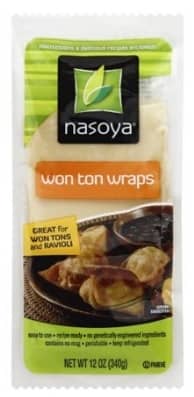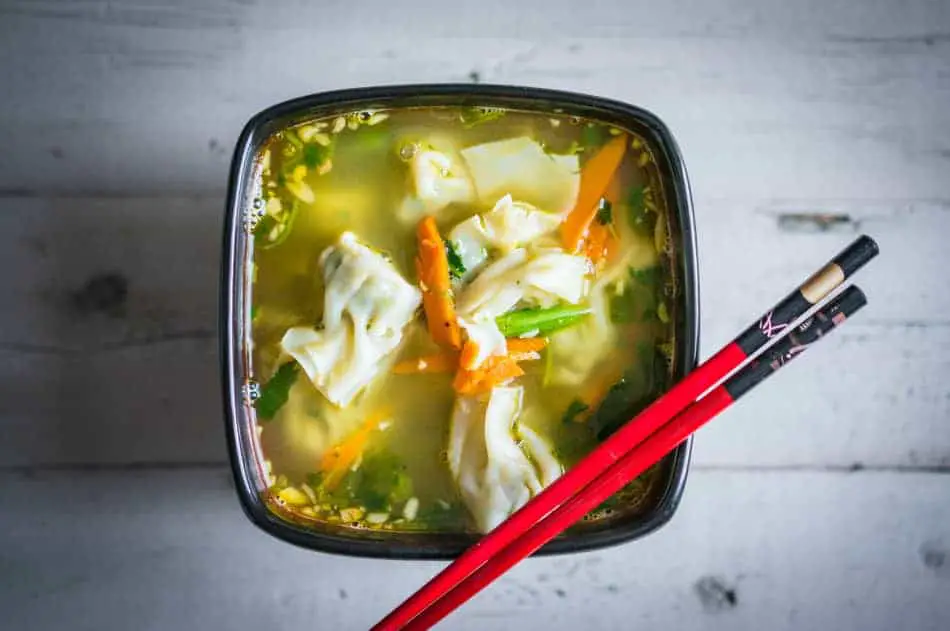A wonton is a type of Chinese dumpling present in most regional styles of Chinese cuisine, especially in wonton soup. The wonton can also be eaten as an appetizer (typically as a fried dumpling) or broken up to be sprinkled on salads. A lot of vegans grew up eating the tasty food products, and want to know if they have to give them up after switching to a 100% plant-based diet.
Are they vegan? Real wontons and wonton soup are never vegan. Wonton wrappers contain egg by default, at which point they’re typically stuffed with meat and served in meat stock or broth. Fried wontons (the appetizer) are usually filled with meat (beef, crab, etc.), and/or cream cheese.
Are they vegetarian? Ovo- and ovo-lacto vegetarians can consume wonton wrappers, and some wonton dumplings–e.g. the cream cheese stuffed variety. But, most wonton soup is off-limits for vegetarians due to the presence of meat and broth.
What we’ll do here is go over the various non-vegan ingredients you’ll encounter in wonton soup, and whether or not there are any vegan-friendly commercial wonton products on the market.
Non-Vegan Ingredients Common in Wontons and Wonton Soup
Egg (Wonton Wrappers)
The first thing to consider is the wonton itself, or the wonton wrapper. Wontons are a type of pasta, and as such, can contain egg.
While a lot of traditional pasta foregoes egg as an ingredient—some only using the yolk for color—wontons make pretty heavy use of egg.
According to Wikipedia, the principle ingredients in wontons wrappers are flour, water, salt, and eggs.1
I did a bit of browsing, and most recipe blogs seem to back this up.2,3
Anyway, it probably comes as no surprise that the wonton itself can be problematic for vegans, given the status of other types of pasta in the vegan community.
The main difference between wontons and other forms of pasta is the shape by which it is identified. The pasta’s characteristic shape is formed by placing fresh dough into a cylinder that then forces it through a series of holes in small disks, or dies. This is what they call extruding the pasta.
After that, the pasta is cut and dried to reach a moisture level of about 31% to 10 or 12%.4
Pasta goes by various names depending on the type of disc used, such as spaghetti (“little strings”), vermicelli (“little worms”), linguine (“little tongues”), rigatoni (“grooved”), or capellini, fettuccine, tortellini, cannelloni, ravioli, lasagna, macaroni, noodles, and wonton wrappers.5
So, egg is the first potential problem. I’m not saying there never will be any eggless wontons on the market. New vegan specialty products are surfacing all the time. But as for now, egg seams be standard.
Meat Stock and Chicken Broth (Wonton Soup)
In American Chinese cuisine (both the US and Canada), you can find wontons in a couple of different forms:
- Appetizers. Fried wontons are commonly served as appetizers at Chinese restaurants, especially the buffets
- Wonton soups. This is just wontons in a clear liquid broth.
The soup form can pose several problems, as we’ll see, but broth is one of the main ingredients you’ll have to deal with.
Granted, there are plenty of vegetable broths on the market. While these would be great for making your own homemade wonton soup (along with an egg-free wonton replacement of course), but you can’t count on vegetarian broth coming standard in most soups. Unless, of course, a restaurant’s menu has a vegetarian/vegan section.
It is possible that no broth would be used, and that water would serve as the only medium, but I wouldn’t count on it.
Fillings: Meats and Cheeses
This is a problem for both wonton soup and fried wontons.
Most fried wontons are prepared with a meat filling—usually pork. To make matters worse, they’re often topped off with a duck sauce, though plum and/or hot and sour sauces can be used, as well as hot mustard.1
Then, there’s cream cheese. I used to LOVE these prior to going vegan. Deep-fried cream cheese is what I call comfort food.
But, unless you’re a lacto-vegetarian, cream cheese is off the menu.
Also, a lot of the cream cheese wontons tend to be stuffed with crab meat as well, in which case the appetizer is called a rangoon. So, this version is often unsuitable even for lacto-vegetarians.
With fried wontons, cream cheese is also often paired with garlic, green onions, and soy sauce.
So, egg in the dough and meat/cheese fillings pose problems for vegans. Wontons are traditionally made by spreading a square wrapper made of flour, egg, salt, and water until it’s flat in the palm of one’s hand, and then placing a small amount of meat-laden filling before sealing it off.6,7
It turns out, the most common fillings in wonton dumplings are ground pork and shrimp with a bit of flour as a binder.8
It may be mixed with some plant-based ingredients such as spices, garlic, and finely chopped green onion, but pork and/or shrimp make up the bulk of most wonton fillings.
Commercial Vegan Wonton Products
There currently aren’t any commercial pre-made wonton soups on the market.
As for wrappers, unfortunately, the default wonton wrapper contains egg. However, spring roll wrappers can be substituted and don’t contain any egg.
Spring rolls fry up nice and crispy but do have a slightly different texture. These wraps have a smoother surface and lighter feel.
Because wonton wrappers contain eggs, they tend to have a texture and color closer to that of egg-rolls.
Nasoya makes a good wonton wrapper.

It contains:9
- Enriched wheat flour with the usual reduced iron and B vitamin fortifications
- Water, gluten, and salt
- Sodium propionate and sodium benzoate (slow spoilage)
- Citric acid and l-cysteine.
It’s up to your discretion whether or not you’d want to consume food products containing l-cysteine. It’s typically derived from feathers and dog hair but is often made synthetically—mostly when food manufacturers want to be compliant with Muslim halal and Jewish kosher laws.10
So, with veggie broth and a few plant-based fillings, you’ll be well on your way to a homemade 100% vegan wonton soup.
That’s it for the vegan status of wontons and wonton soup. Thanks for reading.
You may also want to check out the following related articles:
References
- Wontonts. https://en.wikipedia.org/wiki/Wonton
- Gluten Free Wonton Wrapper – Your New Go-to-Recipe! Jules Shepard – https://gfjules.com/recipes/gluten-free-wonton-wrapper-recipe/
- Wonton Wrappers Recipe. Brianna Johnson-Tara Owens – https://www.allrecipes.com/recipe/20881/wonton-wrappers/
- Smewing J. Analyzing the texture of pasta for quality control. Cereal Foods World 42(1):8–12, 1997.
- Understanding Food: Principles and Preparation (Page 359). Amy Brown – Wadsworth Cengage Learning – 2011
- Make Chinese Wonton Wrapper Three Different Ways. Liv Wan – http://chinesefood.about.com/od/dimsumwonton/r/wontonwrapper.htm
- Kitchen Simplicity. https://web.archive.org/web/20120229113623/http://kitchensimplicity.com/wonton-wrappers/
- Wonton Soup. https://www.recipetineats.com/wonton-soup/
- Nasoya Won Ton Wraps 12 Oz. Pack. Jnally- Reignqueen- Cathy – https://www.walmart.com/ip/Nasoya-Won-Ton-Wraps-12-oz-Pack/10898815
- Questions About Food Ingredients. https://www.vrg.org/nutshell/faqingredients.htm#cystine

